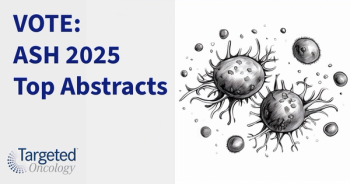
Ropeginterferon Alfa-2b Has Long-Term Benefits in Polycythemia Vera
A novel pegylated formulation of interferon alfa-2b achieved a significantly higher rate of complete hematologic response compared with hydroxyurea (Hydrea) in patients with polycythemia vera, according to 2-year findings from the follow-up phase III CONTI-PV randomized trial.
Heinz Gisslinger, MD
A novel pegylated formulation of interferon alfa-2b achieved a significantly higher rate of complete hematologic response (CHR) compared with hydroxyurea (Hydrea) in patients with polycythemia vera (PV), according to 2-year findings from the follow-up phase III CONTI-PV randomized trial.1
After 24 months of treatment and follow-up, patients treated with ropeginterferon alfa-2b had a CHR rate of 70.5% versus 49.3% with hydroxyurea (P= .0101). Ropeginterferon alfa-2a achieved the composite endpoint of CHR and improved disease burden in 49.5% of patients versus 36.6% for hydroxyurea, a difference that did not reach statistical significance (P= .1183).
Ropeginterferon alfa-2a also achieved partial molecular response almost twice as often as the long-time standard therapy, as reported at the 2017 ASH Annual Meeting in Atlanta.
“Ropeginferferon alfa-2b appears more efficacious than hydroxyurea in the long run, showing high and durable hematological responses and symptom improvement,” said Heinz Gisslinger, MD, professor of hematology at the Medical University of Vienna in Austria. “The safety and tolerability of ropeginterferon alfa-2b remain excellent beyond the second year of treatment.
“The unique disease modification capability of interferon and its potential to improve progression-free survival are suggested by the observed effects on mutantJAK2and other molecular markers.”
Used since the 1980s to treat PV, interferons have consistently achieved high rates of hematologic response and improved other clinical outcomes. Ropeginterferon alfa-2b is a monopegylated formulation of interferon alfa-2b administered every 14 days initially and then once monthly during long-term maintenance treatment. The phase II PEGINVERA study demonstrated the feasibility, efficacy, and tolerability of long-term maintenance therapy with ropeginterferon alfa-2b for PV.
Gisslinger reported findings from a continuation phase of the randomized phase III PROUD-PV trial, which compared outcomes after 12 months of treatment with ropeginterferon alfa-2b and hydroxyurea. Patients in the control arm were also able to switch to best available therapy instead of hydroxyurea at the investigators discretion.
At the 12-month landmark, ropeginterferon alfa-2b demonstrated noninferiority to hyaluronic acid, achieving a CHR rate of 43.1% as compared with 45.6% for the control arm. As reported at the 2016 ASH Annual Meeting, ropeginterferon alfa-2b had a better safety profile, reflected in an adverse event (AE) rate of 59.6% versus 75.6% among patients randomized to hyaluronic acid.2
PROUD-PV involved 257 patients, 171 of whom entered the continuation trial (CONTI-PV), 95 were originally randomized to ropeginterferon alfa-2b and 76 to hyaluronic acid. Follow-up will continue for as long as 3.6 years. Gisslinger reported results after 24 months of follow-up.
The 24-month evaluation had 3 key efficacy endpoints: CHR, defined as hematocrit <45% without phlebotomy, platelet count <400 x 109/L, and white blood cell count <10 x 109/L; CHR and improvement in disease burden, defined as improvement in disease-related signs and symptoms; and partial molecular response (reflecting the effect on mutantJAK2allele burden).
The updated results showed that the noninferiority for CHR had changed to a 42% superiority for ropeginterferon alfa-2b. The 13% absolute difference in the composite endpoint of CHR and improvement in disease burden represented a 34% improvement in favor of ropeginterferon alfa-2b. The rate of partial molecular response was 68.1% with ropeginterferon alfa-2b and 34.7% with hyaluronic acid, an 85% difference in relative risk (P= .0002).
The safety analysis showed that almost 90% of patients in both groups experienced AEs. The incidence of treatment-related AEs was 70.1% with ropeginterferon alfa-2b and 77.2% with hyaluronic acid. Grade ≥3 AEs occurred in 27.6% in the ropeginterferon alfa-2b group and in 26.0% of patients in the hyaluronic group.
The most common AEs were thrombocytopenia (19.7% with ropeginterferon alfa-2b, 26.8% of the control group), leukopenia (18.9%, 22.0%), anemia (9.4%, 22.0%), and elevated gamma-glutamyl transferase (11.0%, 0%). Interferon-associated AEs occurred more often with ropeginterferon alfa-2b: endocrine disorders (3.9%, 0.8%); psychiatric disorders (2.4L%, 0.8%); cardiac/vascular disorders (10.2%, 5.5%); and tissue disorders (1.6%, 0%). Five malignancies occurred in the control group and 3 in the ropeginterferon alfa-2b group.
The reduction inJAK2allele burden increased over time with ropeginterferon alfa-2b, whereas hyaluronic acid achieved greater reductions early in the course of treatment and the effect declined over time.
References
- Gisslinger H, Klade C, Georgiev P, et al. Ropeginterferon alfa-2b induces high rates of clinical, hematological and molecular responses in polycythemia vera: two-year results from the first prospective randomized controlled trial. Presented at: 2017 ASH Annual Meeting; December 9-12, 2017; Atlanta, GA. Abstract 320.
- Gisslinger H, Klade C, Georgiev P, et al. Final results from PROUD-PV a randomized controlled phase 3 trial comparing ropeginterferon alfa-2b to hydroxyurea in polycythemia vera patients. Presented at: 2016 ASH Annual Meeting; December 3-6, 2016; San Diego, CA. Abstract 475.









































